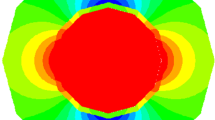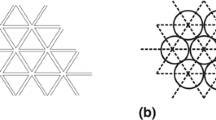Abstract
The discrete element method (DEM) is used for continuous material modeling. The method is based on discretizing mass material into small elements, usually spheres, which are linked to their neighbors through bonds. If DEM has shown today its ability to model isotropic materials, it is not yet the case of anisotropic media. This study highlights the obstacles encountered when modeling orthotropic materials. In the present application, the elements used are spheres and bonds are Euler–Bernoulli beams developed by André et al. (Comput Methods Appl Mech Eng 213–216:113–125, 2012. https://doi.org/10.1016/j.cma.2011.12.002). Two different modeling approaches are considered: cubic regular arrangements, where discrete elements are placed on a regular Cartesian lattice, and random sphere-packed arrangements, where elements are randomly packed. As the second approach is by definition favoring the domain’s isotropy, a new method to affect orientation-dependent Young’s modulus of bonds is proposed to create orthotropy. Domains created by both approaches are loaded in compression in-axis (along the material orthotropic directions) and off-axis to determine their effective Young’s modulus according to the loading direction. Results are compared to the Hankinson model which is especially used to represent high orthotropic behavior such as encountered in wood or synthetic fiber materials. For this class of materials, it is shown that, contrary to cubic regular arrangements, the random sphere-packed arrangements exhibit difficulties to reach highly orthotropic behavior (in-axis tests). Conversely, this last arrangements display results closer to continuous orthotropic material during off-axis tests.










Similar content being viewed by others
References
Jauffrès D, Martin CL, Lichtner A, Bordia RK (2012) Simulation of the elastic properties of porous ceramics with realistic microstructure. Model Simul Mater Sci Eng 20:045009. https://doi.org/10.1088/0965-0393/20/4/045009
Jefferson G, Haritos GK, McMeeking RM (2002) The elastic response of a cohesive aggregate—a discrete element model with coupled particle interaction. J Mech Phys Solids 50:2539–2575. https://doi.org/10.1016/S0022-5096(02)00051-0
Potyondy DO, Cundall PA (2004) A bonded-particle model for rock. Int J Rock Mech Min Sci 41:1329–1364. https://doi.org/10.1016/j.ijrmms.2004.09.011
Swope WC, Andersen HC, Berens PH, Wilson KR (1982) A computer simulation method for the calculation of equilibrium constants for the formation of physical clusters of molecules: application to small water clusters. J Chem Phys 76:637–649. https://doi.org/10.1063/1.442716
Levitt M, Warshel A (1975) Computer simulation of protein folding. Nature 253:694–698. https://doi.org/10.1038/253694a0
Cundall PA, Strack OD (1979) A discrete numerical model for granular assemblies. Geotechnique 29:47–65. https://doi.org/10.1680/geot.1979.29.1.47
André D (2012) Modélisation par éléments discrets des phases d’ébauche et de doucissage de la silice. Université de Bordeaux, Bordeaux (in French)
Hentz S, Donzé FV, Daudeville L (2004) Discrete element modelling of concrete submitted to dynamic loading at high strain rates. Comput Struct 82:2509–2524. https://doi.org/10.1016/j.compstruc.2004.05.016
Leclerc W (2017) Discrete element method to simulate the elastic behavior of 3D heterogeneous continuous media. Int J Solids Struct 121:86–102. https://doi.org/10.1016/j.ijsolstr.2017.05.018
Leclerc W, Haddad H, Guessasma M (2017) On the suitability of a discrete element method to simulate cracks initiation and propagation in heterogeneous media. Int J Solids Struct 108:98–114. https://doi.org/10.1016/j.ijsolstr.2016.11.015
Iliev PS, Wittel FK, Herrmann HJ (2018) Discrete element modeling of free-standing wire-reinforced jammed granular columns. Comput Part Mech. https://doi.org/10.1007/s40571-018-0186-7
Espinosa C, Lachaud F, Limido J, Lacome JL, Bisson A, Charlotte M (2015) Coupling continuous damage and debris fragmentation for energy absorption prediction by CFRP structures during crushing. Comput Part Mech 2:1–17. https://doi.org/10.1007/s40571-014-0031-6
Eberhard P, Gaugele T (2013) Simulation of cutting processes using mesh-free Lagrangian particle methods. Comput Mech 51:261–278. https://doi.org/10.1007/s00466-012-0720-z
Iliescu D, Gehin D, Iordanoff I, Girot F, Gutiérrez ME (2010) A discrete element method for the simulation of CFRP cutting. Compos Sci Technol 70:73–80. https://doi.org/10.1016/j.compscitech.2009.09.007
Pfeiffer R, Lorong P, Ranc N (2015) Simulation of green wood milling with discrete element method. In: Proceedings of 22nd international wood machining seminar IWMS 2015, pp 57–72
Roux A, Laporte S, Lecompte J, Gras LL, Iordanoff I (2016) Influence of muscle-tendon complex geometrical parameters on modeling passive stretch behavior with the discrete element method. J Biomech 49:252–258. https://doi.org/10.1016/j.jbiomech.2015.12.006
Duan K, Kwok CY, Pierce M (2016) Discrete element method modeling of inherently anisotropic rocks under uniaxial compression loading. Int J Numer Anal Methods Geomech 40:1150–1183. https://doi.org/10.1002/nag.2476
Lochmann K, Oger L, Stoyan D (2006) Statistical analysis of random sphere packings with variable radius distribution. Solid State Sci 8:1397–1413. https://doi.org/10.1016/j.solidstatesciences.2006.07.011
Le BD, Dau F, Charles JL, Iordanoff I (2016) Modeling damages and cracks growth in composite with a 3D discrete element method. Compos Part B Eng 91:615–630. https://doi.org/10.1016/j.compositesb.2016.01.021
Maheo L, Dau F, André D, Charles JL, Iordanoff I (2015) A promising way to model cracks in composite using discrete element method. Compos Part B Eng 71:193–202. https://doi.org/10.1016/j.compositesb.2014.11.032
André D, Iordanoff I, Charles JL, Néauport J (2012) Discrete element method to simulate continuous material by using the cohesive beam model. Comput Methods Appl Mech Eng 213–216:113–125. https://doi.org/10.1016/j.cma.2011.12.002
Hankinson RL (1921) Investigation of crushing strength of spruce at varying angles of grain. Air Serv Inf Circ 3:130
Cramer SM, McDonald KA (1989) Predicting lumber tensile stiffness and strength with local grain angle measurements and failure analysis. Wood Fiber Sci J Soc Wood Sci Technol, USA
Kenney JF (2013) Mathematics of statistics. Literary Licensing, LLC, New York
Radcliffe BM (1965) A theoretical evaluation of Hankinson’s formula for modulus of elasticity of wood at an angle to the grain. Quart Bull Mich Agric Exp Sta 48:286–295
Yoshihara H (2009) Prediction of the off-axis stress–strain relation of wood under compression loading. Eur J Wood Wood Prod 67:183–188. https://doi.org/10.1007/s00107-009-0320-6
Acknowledgements
The authors would like to acknowledge GranOO staff members, especially Jean-Luc Charles and Damien André for the training they provided.
Funding
These works were conducted thanks to the support of the region Bourgogne Franche-Comté and were funded by the ANR-10-EQPX-16 XYLOFOREST-XYLOMAT and the French MESRI.
Author information
Authors and Affiliations
Corresponding author
Ethics declarations
Conflict of interest
The authors declare that they have no conflict of interest.
Rights and permissions
About this article
Cite this article
Curti, R., Girardon, S., Pot, G. et al. How to model orthotropic materials by the discrete element method (DEM): random sphere packing or regular cubic arrangement?. Comp. Part. Mech. 6, 145–155 (2019). https://doi.org/10.1007/s40571-018-0202-y
Received:
Revised:
Accepted:
Published:
Issue Date:
DOI: https://doi.org/10.1007/s40571-018-0202-y




